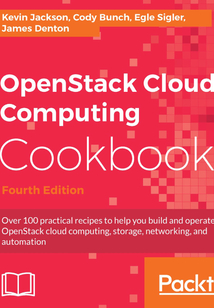首頁 > 計(jì)算機(jī)網(wǎng)絡(luò) >
編程語言與程序設(shè)計(jì)
> OpenStack Cloud Computing Cookbook(Fourth Edition)最新章節(jié)目錄
舉報(bào) 

會(huì)員
OpenStack Cloud Computing Cookbook(Fourth Edition)
最新章節(jié):
Index
Thisbookiswrittenforcloudsystemengineers,systemadministrators,andtechnicalarchitectswhoaremovingfromavirtualizedenvironmenttocloudenvironments.Thisbookassumesthatyouarefamiliarwithcloudcomputingplatforms,andhaveknowledgeofvirtualization,networking,andmanagingLinuxenvironments.
目錄(148章)
倒序
- coverpage
- OpenStack Cloud Computing Cookbook Fourth Edition
- www.mapt.io
- Why subscribe?
- PacktPub.com
- Contributors
- About the authors
- About the reviewers
- Packt is searching for authors like you
- Preface
- Who this book is for
- What this book covers
- To get the most out of this book
- Sections
- Get in touch
- Chapter 1. Installing OpenStack with Ansible
- Introduction – the OpenStack architecture
- Host network configuration
- Root SSH keys configuration
- Installing Ansible playbooks and dependencies
- Configuring the installation
- Running the OpenStack-Ansible playbooks
- Troubleshooting the installation
- Manually testing the installation
- Modifying the OpenStack configuration
- Virtual lab - vagrant up!
- Chapter 2. The OpenStack Client
- Introduction – using OpenStack
- Installing Python on Windows
- Installing the OpenStack clients
- Configuring your Linux or macOS environment
- Configuring your Windows environment
- Common OpenStack networking tasks
- Common OpenStack server (instances) tasks
- Common OpenStack image tasks
- Common OpenStack identity tasks
- Common OpenStack storage tasks
- Common OpenStack orchestration tasks
- Chapter 3. Keystone – OpenStack Identity Service
- Introduction – OpenStack Identity
- Creating OpenStack domains in Keystone
- Enabling domains in the OpenStack dashboard
- Creating OpenStack projects in Keystone
- Configuring roles in Keystone
- Adding users in Keystone
- Configuring groups in Keystone
- Deleting projects
- Deleting users
- Deleting roles
- Deleting groups
- Deleting domains
- OpenStack endpoint information
- Chapter 4. Neutron – OpenStack Networking
- Introduction to OpenStack networking
- Managing networks subnets and ports
- Creating provider networks
- Creating tenant networks
- Creating ports
- Updating network attributes
- Deleting ports
- Deleting networks
- Managing routers and floating IPs
- Attaching networks to routers
- Creating and assigning floating IPs
- Deleting routers
- Managing security groups
- Managing load balancers
- Chapter 5. Nova – OpenStack Compute
- Introduction to OpenStack Compute
- Adding a compute host using OpenStack-Ansible
- Suspending a host for maintenance
- Configuring Nova Scheduler to use host aggregates
- Creating a host aggregate
- Adding a compute host to a host aggregate
- Removing a compute host from a host aggregate
- Adding metadata to a host aggregate
- Deleting a host aggregate
- Creating an Availability Zone
- Booting an instance into an Availability Zone
- Removing an Availability Zone
- Creating a flavor
- Deleting a flavor
- Setting CPU limits for a flavor
- Setting IOPS limits for a flavor
- Booting an instance
- Stopping an instance
- Deleting an instance
- Live migration
- Snapshotting an instance
- Booting an instance from a snapshot
- Rescuing an instance
- Shelving an instance
- Reviewing the console logs
- Chapter 6. Glance – OpenStack Image Service
- Introduction to OpenStack Image services
- Managing images
- Using image snapshots
- Using image metadata
- Protecting images
- Deactivating images
- Creating custom images
- Chapter 7. Cinder – OpenStack Block Storage
- Introduction
- Configuring Cinder volume services
- Creating volumes
- Attaching volumes to an instance
- Detaching volumes from an instance
- Deleting volumes
- Working with volume snapshots
- Configuring volume types
- Enabling volume encryption
- Configuring volume Quality of Service (QoS)
- Resetting volume state
- Chapter 8. Swift – OpenStack Object Storage
- Introduction – OpenStack Object Storage
- Creating object containers
- Deleting object containers
- Uploading objects
- Uploading large objects
- Downloading objects
- Deleting objects
- Container ACLs
- Chapter 9. OpenStack Orchestration Using Heat and Ansible
- Introduction – orchestrating with OpenStack
- Creating your first stack
- Launching your stack with Heat
- Viewing the resources and output of a stack created with Heat
- Deleting a Heat stack
- Updating a Heat stack
- Installing and configuring Ansible for OpenStack
- Using Ansible to launch instances
- Using Ansible to orchestrate software installation
- Using Ansible to orchestrate software installations across multiple instances
- Using Ansible to fully orchestrate the creation of a web server and load balancer stack
- Chapter 10. Using OpenStack Dashboard
- Introduction – OpenStack Dashboard
- Using OpenStack Dashboard for key management
- Using OpenStack Dashboard to manage Neutron networks and routers
- Using OpenStack Dashboard for security group management
- Using OpenStack Dashboard to launch instances
- Using OpenStack Dashboard to delete instances
- Using OpenStack Dashboard to add new projects
- Using OpenStack Dashboard for user management
- Using OpenStack Dashboard with LBaaS
- Using OpenStack Dashboard with OpenStack Orchestration
- Another Book You May Enjoy
- Leave a review – let other readers know what you think
- Index 更新時(shí)間:2021-07-02 16:25:45
推薦閱讀
- Clojure Programming Cookbook
- FuelPHP Application Development Blueprints
- Django+Vue.js商城項(xiàng)目實(shí)戰(zhàn)
- Pandas Cookbook
- Maven Build Customization
- 精通搜索分析
- Mastering Python Scripting for System Administrators
- jQuery從入門到精通 (軟件開發(fā)視頻大講堂)
- C程序設(shè)計(jì)實(shí)踐教程
- Python Data Structures and Algorithms
- Go語言開發(fā)實(shí)戰(zhàn)(慕課版)
- Android Development Tools for Eclipse
- 遠(yuǎn)方:兩位持續(xù)創(chuàng)業(yè)者的點(diǎn)滴思考
- Mastering ASP.NET Core 2.0
- Scratch編程從入門到精通
- C語言從入門到精通(微視頻精編版)
- 軟件測(cè)試項(xiàng)目實(shí)戰(zhàn)之功能測(cè)試篇
- Java與Android移動(dòng)應(yīng)用開發(fā):技術(shù)、方法與實(shí)踐
- 深度剖析ApacheDubbo核心技術(shù)內(nèi)幕
- Java EE 7 First Look
- Python 3 Text Processing with NLTK 3 Cookbook
- OpenCL Programming by Example
- WebGL編程指南
- Full Stack Web Development with Raspberry Pi 3
- Hadoop技術(shù)內(nèi)幕:深入解析YARN架構(gòu)設(shè)計(jì)與實(shí)現(xiàn)原理
- Drupal 7 Media
- 數(shù)據(jù)結(jié)構(gòu)(C語言版)(第2版)
- Clojure Data Analysis Cookbook(Second Edition)
- Mastering Jenkins
- INSTANT HTML5 Responsive Table Design How-to

